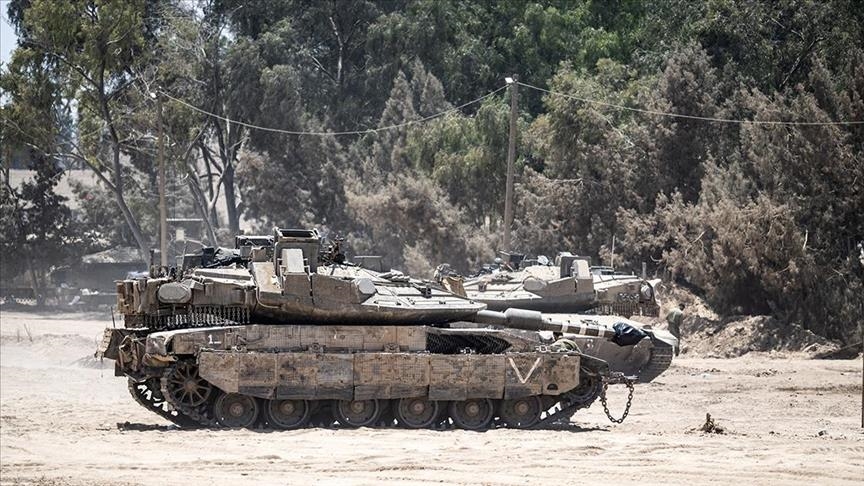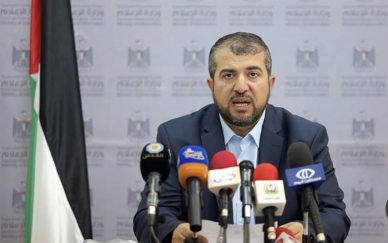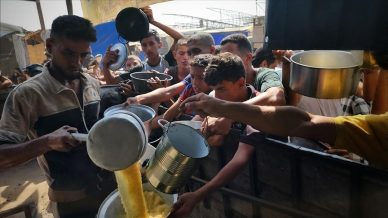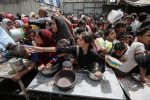RAFAH, (PIC)
For more than two weeks, the Israeli occupation army has been launching a multi-front ground military operation, starting from Salah al-Din Street—formerly known as the Netzarim Axis—in the center of the Gaza Strip, expanding to encompass the entire city of Rafah and the eastern part of Khan Yunis in the south, before extending to the Shujaiya neighborhood in the east of Gaza City, as well as Beit Hanoun and Beit Lahia in the north, in addition to the northern coastal strip of the territory.
In a repeat of what the Israeli occupation army did in the north of the Gaza Strip in October 2024 under what was known as the “Generals’ Plan,” the Hebrew newspaper Haaretz revealed the occupation army’s efforts to annex the city of Rafah—which constitutes one-fifth of the Gaza Strip’s land—to the buffer zone that Israel prohibits Palestinians from entering.
The newspaper said that the buffer zone the occupation army is preparing to establish covers 75 square kilometers, located between the Philadelphi and Morag axes, and includes Rafah city and its neighboring districts in the southern part of the Palestinian territory—effectively meaning the annihilation of any existence of the city.
Haaretz added that under the annexation of Rafah and its surrounding neighborhoods into the buffer zone, the occupation army will not allow Palestinian civilians to return to Rafah, “and is considering the demolition of all buildings in it.”
According to Haaretz, annexing a city the size of Rafah to Israel’s new buffer zone “will turn the Gaza Strip into an enclave within Israeli territory, distancing it from the Egyptian border.”
The newspaper based this view on Israeli military sources, noting that the proposed plan for Rafah and its surrounding areas is a “repeat of what was done in the north of the Gaza Strip.”
On March 29, the occupation army announced the expansion of its ground operation in the south of the Gaza Strip to enlarge the buffer security zone it named the “defensive security area,” while warning Palestinians in Rafah to evacuate immediately.
Days later, the occupation army began a wide-scale incursion into the city of Rafah as part of its ongoing military operation in the southern Gaza Strip, after deploying the 36th Combat Division to the area.
Haaretz viewed the talk about annexing Rafah to the buffer zone as stemming from a decision by the political leadership to renew the war on the Gaza Strip last March, in light of a statement by the Israeli Prime Minister Benjamin Netanyahu that Israel would control large parts of the Gaza Strip.
The newspaper continued, “The army now realizes that Israel is unlikely to receive international support for a prolonged operation in the Gaza Strip, even from the United States, and that threats made by members of the government to block humanitarian aid are unlikely to be translated into actual policy. Therefore, the army is preparing to focus its campaign on areas it believes will put pressure on Hamas leadership.”
These claims by the Hebrew newspaper come despite Tel Aviv’s failure to fully impose its control over areas in the northern Gaza Strip, where it had tried for months to evacuate residents from Beit Lahia and Jabalia in hopes of establishing a wider buffer zone to separate its settlements from the Strip.
In this context, Haaretz quoted Israeli soldiers criticizing Tel Aviv’s policies throughout the course of the war. Reserve officers and soldiers told the newspaper, “The army keeps repeating the same messages since the beginning of the war, without facing reality… the military operations are taking us back to square one, without anyone knowing how long this will last, what the objective of the operation is, or what has been achieved operationally.”
This revelation by Haaretz came just days after the Israeli occupation army announced last Saturday the start of military operations in what is known as the Morag Axis in the southern Gaza Strip. Palestinian warnings followed, asserting that this move aims to “sustain the occupation of Gaza and divide it,” as the axis separates the cities of Rafah and Khan Yunis in the south of the Strip.
The axis is named after an Israeli settlement that was located in the Gaza Strip before the occupation withdrew from it in 2005. The Israeli army’s spokesperson, Avichay Adraee, posted photos on the platform X, claiming they showed “the initial operations carried out by the 36th Division forces in the Morag Axis.”
No Palestine exists
Military and strategic expert Brigadier General Elias Hanna stressed that Israeli control over Rafah city would mean total destruction and “the nonexistence of Palestine.”
In a statement to Al Jazeera, Brigadier Hanna said that the map published by Haaretz is not new and that what it presented is merely a tactical development serving the Israeli occupation’s strategic goal, which is related to the so-called “Generals’ Plan” aimed at controlling the north of the Gaza Strip by displacing its residents to the south, then imposing a complete siege on the north.
He explained that the buffer zone was between 700 and 1100 meters at five points, then became more than 100 meters wide due to the systematic demolitions carried out by occupation forces during their continued assault on various areas of the Palestinian territory.
According to Brigadier Hanna, Netanyahu previously declared that the Philadelphia Axis was a matter of life or death due to his belief in the presence of tunnels. He pointed out that the Jerusalem Post had reported that only 25% of Gaza’s tunnels have been destroyed.
He also highlighted statements by Netanyahu and his Army Minister Yoav Gallant, in which they said they would occupy Gaza if Hamas did not release the Israeli captives it holds—statements that, according to Hanna, fall within the occupation’s broader plan to control the Strip.
The same military and strategic expert previously confirmed in an analysis that the focus of the occupation army on Shujaiya, Jabalia, Beit Lahia, and Beit Hanoun are tactical moves within a broader strategy aimed at fragmenting the Gaza Strip and isolating civilians from the resistance.
Regarding the impact of the Israeli operations in Rafah on the Egyptian border, Elias Hanna explained that after Israel’s control of the Rafah crossing, Gaza is completely isolated from Egypt—something that requires a new agreement between the two sides. He questioned Egypt’s position: Will it accept the current situation or not?
Buffer zones
65% of the Gaza Strip’s area has become zones that the occupation army bans entry to, labeling them as “buffer zones,” or areas under evacuation warnings, according to a UN report published by the United Nations Office for the Coordination of Humanitarian Affairs (OCHA) on April 4.
The office explained in its report that since March 18, the occupation army has issued 13 evacuation orders, placing about 126.6 square kilometers—or 35% of the Gaza Strip—under active forced displacement orders.
The report also stated that, in addition to this area, the occupation authorities requested the United Nations to coordinate movement into the prohibited zone along the Gaza Strip, and through the Wadi Gaza area (Netzarim Axis).
The occupation army established the “Netzarim Axis” in early November 2023 at the start of the genocide in the Gaza Strip, to isolate Gaza and North Governorates from the central and southern areas.
The axis extends from the easternmost borders of the Gaza Strip to the western coastline, intersecting with the main Salah al-Din road, before the army withdrew from it in February as part of the first phase of a ceasefire agreement with Palestinian factions—an agreement Israel later reneged on.
OCHA’s report indicated that these areas collectively represent 65% of the Gaza Strip’s area.
As of March 18, when the occupation authorities unilaterally withdrew from the ceasefire agreement, the “buffer zones” the occupation army designated, represented about 17% of the Gaza Strip’s area.
At the beginning of March, the first phase of a ceasefire and prisoner exchange agreement between Hamas and Israel—effective since January 19, 2025—came to an end. While Hamas adhered to the terms of the first phase, the occupation government reneged on the start of the second phase in response to pressure from extremists in the ruling coalition.
With full U.S. support, Israel has been committing acts of genocide in Gaza since October 7, 2023, resulting in over 166,000 Palestinian casualties, most of them women and children, and more than 11,000 missing persons.














